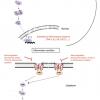Glucosides
Glucosides are natural ingredients modified by a chemical process called glycosylation. Glycosylation makes the ingredients (vitamins and compounds from natural extracts) more stable, bio-available, and water-soluble in formulations. Some glucosides are perfect emollients that also improve the skin's water contents. These parts of beauty formulas can moisturize and soften skin and hair.
There are many glycosides in the planting and animal world. For healing methods, important glycosides are: arbutine in the leaves of Bearberries, salicine in willow bark, anthraglucosides in Rhubarb, and refuse trees. Also, the anthocyans as red and blue dyes of flowers and berries are glycosides. Again other important glucosides are saponins (triterpenoids). The name saponins come to foam from their quality in a watery solution strongly (Sapo is in the Latin soap).
Made from vegetable oils and starch, alkyl glucosides (also called alkylpolyglucosides) are in demand for their performance, mildness, and low ecotoxicity. Alkylpolyglucosides are a unique class of non-ionic surfactants for broad applications in skin and hair care products. Those are widely used in consumer products found on virtually every store shelf, ranging from baby shampoos, facial cleansers, and makeup removers. Alkyl glucosides meet the demand for mild, environmentally green, and powerful ingredients.
Arbutin is a white powder, a hydroquinone derivative glucoside found in many plants. Like hydroquinone, it also effectively inhibits the formation of melanin and prohibits hyper-pigmentation caused by sun exposure and ultraviolet radiation.
Glucosylrutin (α-glucosylrutin or AGR) is a radical scavenger with a strong antioxidant effect and a high skin bioavailability. It is a flavonoid used in dermatological preparation and cosmetic products.
Glyceryl Glucoside (2-O-α-D-Glucopyranosylglycerine) is a natural substance found in Japanese rice wine (sake) and other fermented foods. It is a reactivation and revitalization substance of resurrection plant, Myrothamnus flabellifolia.
Lauryl Methyl Gluceth-10 Hydroxypropyldimonium Chloride is a quaternary ammonium salt of ethoxylated methyl glucose and dimethyl dodecyl ammonium substituted epoxide.
Methyl Gluceth-10 is an ethoxylated methyl glucose ether derived from natural raw material (corn). It is a pale yellow syrup (liquid) with a moderate viscosity and a mild odor.
Methyl Gluceth-20 is an ethoxylated methyl glucose ether, a pale, yellow, moderate-viscosity syrup (liquid) with a mild odor. It is an effective humectant in rinse-off and leave-on skin care products such as lotions, creams, and body cleansing formulations.
Methyl Glucose Dioleate is an amber, viscous liquid. It is a diester of methyl glucose and oleic acid. It is an efficient, nonionic, water-in-oil emulsifier with an HLB value of 4.4. It exhibits good mildness and safety suitable for modern personal care products.
Methyl Glucose Sesquistearate is a mixture of mono- and diesters of methyl glucose and stearic acid, a solid in the form of off-white flakes. It is a nonionic water-in-oil emulsifier with an HLB value of 6.6.
PEG-120 Methyl Glucose Dioleate is an ethoxylated methyl glucose diether esterified with oleic acid. It is a pale yellow solid in the form of waxy flakes with a mild odor.
PEG-20 Methyl Glucose Sesquistearate is an ethoxylated mixture of mono- and diesters of methyl glucose and stearic acid. It is a pale yellow, soft solid with a mild characteristic odor.
PPG-10 Methyl Glucose Ether is a propoxylated methyl glucose ether, a pale, yellow syrup (moderate-viscosity liquid) with a mild odor. It is an effective emollient, fragrance fixative, and humectant for hair and skin care products.
PPG-20 Methyl Glucose Ether is a propoxylated methyl glucose ether, a moderate-viscosity pale, yellow syrup (liquid) with a mild odor. It is an effective emollient, fragrance fixative, and humectant for hair and skin care products.
PPG-20 Methyl Glucose Ether Distearate is a propoxylated methyl glucose ether, a moderate-viscosity pale, amber liquid with a characteristic odor. It is an effective emollient and moisturizer for skin care products.
Various vitamin E derivatives are used in cosmetics as antioxidant and skin conditioning agents. Tocopheryl glucoside is more soluble, stable, and easily transported into the skin in comparison with tocopherol (vitamin E).
Dark circles and bags are reported to be one of the biggest concerns for consumers all over the world and more precisely- ly for the Asiatic population (Mintel data), right after wrinkles.




















